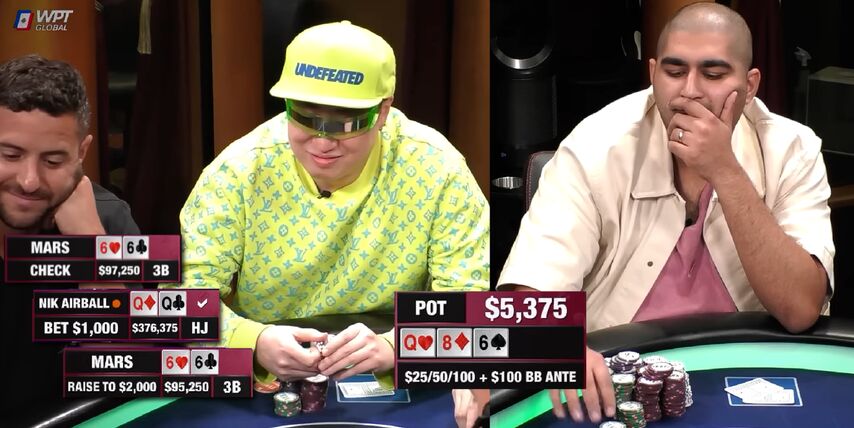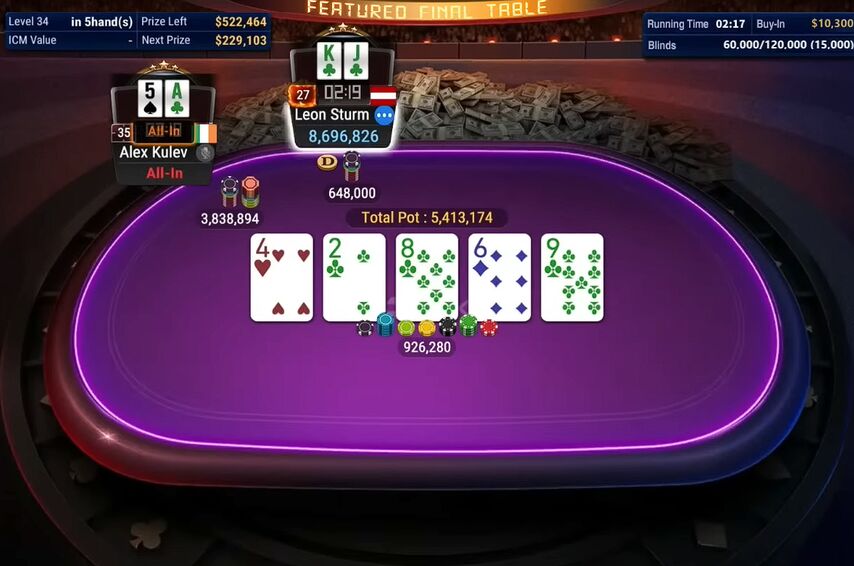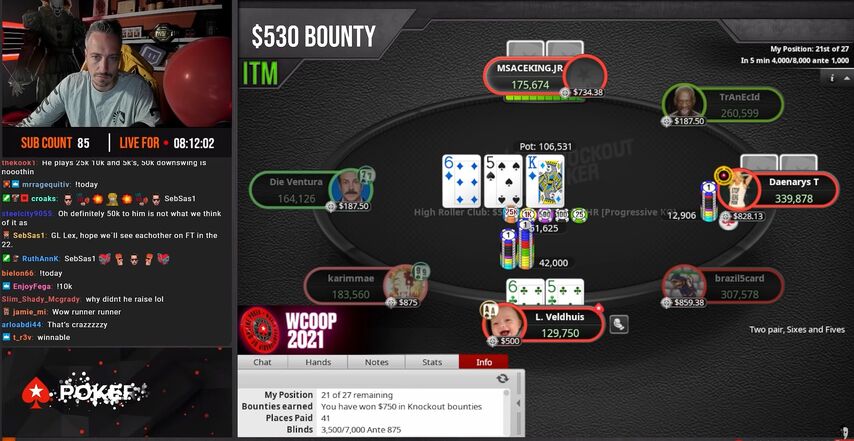What is a check-raise in poker?
A check-raise describes two actions from the same player. Here’s how it works:
- Player 1 makes a check and the action is on their opponent.
- When Player 2 makes a bet, Player 1 raises it.
First a check, then a raise – which gives us the term “check-raise”.

This move only works if you act before the player who bets. If you act after them, you’re just raising – not check-raising.
If you check and then raise, you’re switching the pace of the hand. It’s a move that can create a much larger pot and more value, or force opponents to fold their cards.
We’ll explain the meaning of check-raise in poker a bit more, then look at effectively using it in poker games.
The Meaning of Check Raise in Poker
A check-raise in poker means you have checked, but when your opponent bets, you raise.
Check-raising can be a move to trap your opponent when you have a strong hand and you’re trying to extract more chips. Also, it’s an effective bluff strategy that puts your opponent to the test and could win you the pot immediately.
Since the first action (checking) is passive and doesn’t display any aggression, the raise that follows the check is always a slight surprise. Betting opponents usually don’t need to worry about check raises, but it can create a tough situation when it happens.
Examples of Check Raise in Action
Check out these examples of check-raises.
- You check-raise holding 7♥ 7♦ on a flop of 7♣ A♥ Q♥ because you want to get value from pairs, straight draws, and flush draws.
- You check-raise holding J♠ 10♠ on a flop of 9♠ 8♠ 3♦, because you can win the hand if your opponent folds, and you have strong equity if they call your check-raise.
- You notice that one of your opponents continues betting on the flop almost every time they open-raise preflop, meaning their continuation bet range may be too wide. You exploit with a check-raise, hoping they fold their wide range.
Check raises are usually underused by recreational players, which means you should build them into your strategy. Try out the online cash games, tournaments, or hourly freerolls at partypoker to test your check-raising in real games.
When to Use a Check Raise in Poker
When you check raise in poker games, you have two possible main goals:
1. Check-Raise Bluff or Semi-Bluff
Going from a non-aggressive check to an aggressive raise can look very strong to your opponents. They’ll have to re-evaluate the hands they continue with and fold some of their weaker hands. You can sometimes check-raise semi-bluff with strong drawing hands, like a straight and flush draw.
2. Check-Raise for Value
When you check-raise for value, you’re building a pot and taking an aggressive line. Your opponent will continue with strong hands, draws that have decent potential, and even single pairs with good kickers. With the right size of check-raise, you keep your opponent in the hand but force them to put in more money.

On this hand during the massive GGPoker Millions final table, Alex Kulev check-raises all-in against Leon Sturm’s king-high flush. Alex has the Ace of clubs, which blocks Leon from having the nut flush. This check raise might have worked, but it’s unlikely that Leon would fold a flush in a heads-up situation.
First place took home just under $300,000, while Alex collected $229,000 for second place.
To find out about GGPoker’s MTTs, cash games, and new-player rewards – visit our site review.
Check Raise Sizing
When you check-raise, you are out of position, meaning that you must act first in the hand. Because you will need to play the rest of the hand without a positional advantage, it’s best to make a larger check-raise size.
Don’t min-raise because it’s way too small of a size. Your opponent will have a very easy decision to make since they are in position and it won’t cost them many more chips.
You could choose a size of 2x your opponent's bet, or more than 3x, especially if your opponent’s bet was on the small side (around 25% pot).
Choose a balanced size and avoid changing your check-raise size too often. For example, don’t check-raise for 50% of the pot size in one hand, and then 100% of the pot size in other hands.

In this PokerStars $530 Bounty MTT, Lex Veldhuis chooses to check-raise his opponent's 25% pot bet. He chooses to raise around 3x the opponent's bet, with a little extra on top. From 1.8 bb, he raised it to 6 bb.
It’s important to think about your goal when you check-raise, as that will influence your sizing. You can ask yourself, will my opponent fold some of their hands to this sizing? Which hands can my opponent call with if I use this sizing?
Play in Bounty tournaments like Lex, daily Micro Millions events, or the Sunday Million MTT. This is one of the biggest weekly poker tournaments in the world, with a $1,000,000 guarantee. The buy-in is $109, but you can easily get yourself there for less through satellite tournaments.
Check Raise Strategy: 5 Things to Think About
The check raise isn’t as simple as it looks. To the untrained eye, it may just look like a surprising (and large) raise, but there’s more to it.
1. Have a plan for the next betting round if your opponent calls your check raise.
If you are bluffing or semi-bluffing, you’ve got to have a plan if your opponent decides to see another card. Which cards will you barrel on? Are there any cards that you will check, instead of bet on?
2. If you only check-raise strong hands, you are too predictable.
To be an effective poker player, you’ve got to mix bluffs and semi-bluffs with strong hands. Some players have an equal amount of bluffs and semi-bluffs as strong hands when they check-raise, while others choose to have more bluffs and semi-bluffs than value.
3. Check-raise your low sets most of the time, not your top sets.
If you have bottom set, it’s more likely that your opponent will connect with the higher cards. This means you can check-raise these bottom sets more often and get called by opponents with top pair or top two pair.
4. Be careful check raising against a short-stacked opponent.
If you check-raise an opponent who doesn’t have many chips, be ready for them to move all in. You have less fold equity with a short-stacked opponent since they have already committed a larger percentage of their chips. If you check-raise them, you should have a stronger range to call their shove – if it comes.
5. Check-raise bluff on boards that favor your range.
For example, if you are in the big blind position and the flop comes 10♥ A♣ J♦, this board favors the raiser’s range – not yours. The kinds of hands that the raiser has in their range interact with this board more than the big blind’s range.


















